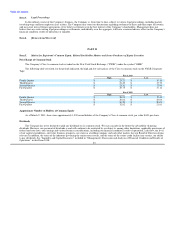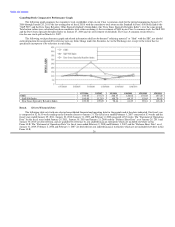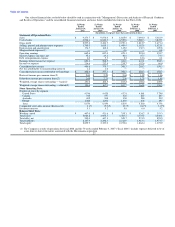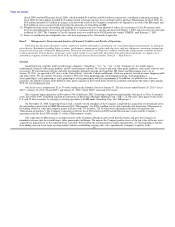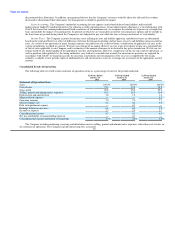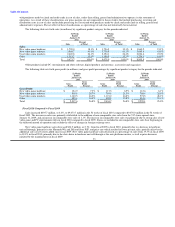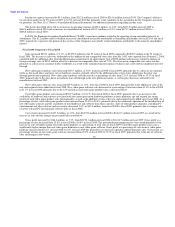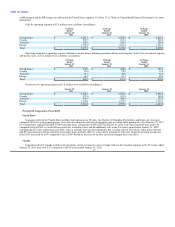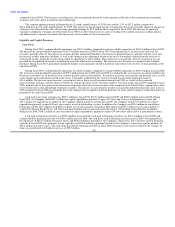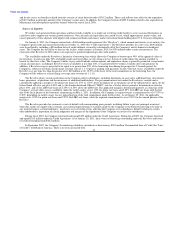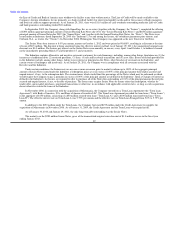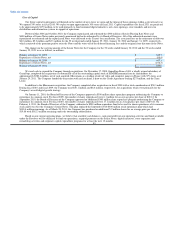GameStop 2010 Annual Report Download - page 50
Download and view the complete annual report
Please find page 50 of the 2010 GameStop annual report below. You can navigate through the pages in the report by either clicking on the pages listed below, or by using the keyword search tool below to find specific information within the annual report.
Table of Contents
New video game software sales increased $237.8 million, or 6.4%, from fiscal 2009 to fiscal 2010, primarily due to strong sales of new video
game titles released in fiscal 2010, compared to fiscal 2009, as well as sales from new stores added since fiscal 2009. New video game software
sales increased as a percentage of total sales from 41.1% in fiscal 2009 to 41.9% in fiscal 2010, primarily due to the new release sales growth and the
slow-down in hardware unit sell-through discussed above.
Used video game product sales increased $75.7 million, or 3.2%, from fiscal 2009 to fiscal 2010, primarily due to the increase in the
availability of hardware and software associated with the current generation hardware platforms as those platforms age and expand and the
additional sales at new stores added since fiscal 2009. As a percentage of sales, used video game product sales decreased from 26.4% to 26.1%,
primarily due to the increase in new release video game software sales and other product sales. Sales of other product categories, including PC
entertainment and other software and accessories, increased 9.9%, or $118.7 million, from fiscal 2009 to fiscal 2010, primarily due to stronger sales
of newly-released PC entertainment software titles in fiscal 2010 and an increase in revenue associated with the Company's loyalty program.
Cost of sales increased by $292.8 million, or 4.4%, from $6,643.3 million in fiscal 2009 to $6,936.1 million in fiscal 2010 as a result of the
increase in sales and the changes in gross profit discussed below.
Gross profit increased by $102.9 million, or 4.2%, from $2,434.7 million in fiscal 2009 to $2,537.6 million in fiscal 2010. Gross profit as a
percentage of sales was 26.8% in fiscal 2009 and fiscal 2010. Gross profit as a percentage of sales on new video game hardware increased from
6.5% in fiscal 2009 to 7.3% in fiscal 2010 due primarily to an increase in product replacement plan sales. Gross profit as a percentage of sales on
new video game software decreased from 21.3% in fiscal 2009 to 20.7% in fiscal 2010, primarily due to a decrease in vendor allowances received,
net of advertising expenses. Advertising expenses increased, due in part to expenses associated with the Company's new loyalty program. Gross
profit as a percentage of sales on used video game products decreased from 46.8% in fiscal 2009 to 46.2% in fiscal 2010 primarily due to
promotional activities in the holiday selling season and a shift in sales from older hardware and software platform sales, which generate higher gross
margins as platforms age, to current generation platform sales which have lower gross margins. Gross profit as a percentage of sales on the other
product sales category increased from 33.8% in fiscal 2009 to 34.4% in fiscal 2010 primarily due to a shift in sales to higher margin accessories,
increases in revenue associated with the Company's loyalty program and the increase in sales of digital online game cards, some of which are
recorded on a commission basis at 100% margin.
Selling, general and administrative expenses increased by $65.2 million, or 4.0%, from $1,635.1 million in fiscal 2009 to $1,700.3 million in
fiscal 2010. The increase was primarily attributable to the increase in the number of stores in operation and the related increases in store, distribution
and corporate office operating expenses, as well as expenses incurred in our digital and loyalty initiatives in fiscal 2010. Selling, general and
administrative expenses as a percentage of sales were 18.0% in fiscal 2009 and fiscal 2010. Selling, general and administrative expenses include
$29.6 million and $37.8 million in stock-based compensation expense for fiscal 2010 and fiscal 2009, respectively. Foreign currency transaction
gains and (losses) are included in selling, general and administrative expenses and amounted to $2.5 million in fiscal 2010, compared to $3.8 million
in fiscal 2009.
Depreciation and amortization expense increased $12.1 million from $162.6 million in fiscal 2009 to $174.7 million in fiscal 2010. This
increase was primarily due to capital expenditures associated with the opening of 359 new stores during fiscal 2010 and investments in strategic
initiatives and management information systems. Depreciation and amortization expense is expected to increase from fiscal 2010 to fiscal 2011 due
to continued investments in new stores, management information systems and other strategic initiatives.
Interest income resulting from the investment of excess cash balances decreased from $2.2 million in fiscal 2009 to $1.8 million in fiscal 2010
as a result of lower invested cash balances and lower interest rates during fiscal 2010. Interest expense decreased from $45.4 million in fiscal 2009 to
$37.0 million in fiscal 2010, primarily due to the retirement of $200.0 million of the Company's senior notes since January 30, 2010 and the
retirement of $100.0 million of the Company's senior notes during fiscal 2009. Debt extinguishment expense of $6.0 million and $5.3 million was
recognized in fiscal 2010 and fiscal 2009, respectively, as a result of the premiums paid related to debt retirement and the recognition of deferred
financing fees and unamortized original issue discount. 34


